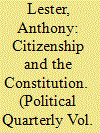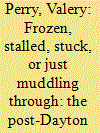| Srl | Item |
| 1 |
ID:
084487


|
|
|
|
|
| Publication |
2008.
|
| Summary/Abstract |
The status of "British subjects", the relationship between the individual and the State, and the concept of "rights" and "liberties" are relevant to the current political debate about "British identity", citizenship, "multiculturalism", a "British Bill of Rights", and whether there is now a need for a written constitution. This article describes the confused contemporary understanding of what is meant by "British" citizenship and analyses the parallel developments of citizenship and our constitutional arrangements. The Human Rights Act, devolution and Gordon Brown's proposed constitutional renewal are important steps in setting out the ideas and principles that bind us together as a nation. Together with a coherent definition of the rights and obligations of British citizenship, constitutional reform would achieve a stronger sense of what it means to be British today.
|
|
|
|
|
|
|
|
|
|
|
|
|
|
|
|
| 2 |
ID:
163167


|
|
|
|
|
| Summary/Abstract |
The war in Bosnia and Herzegovina (BiH) ended in 1995, yet the state remains crippled by inertia, escalating political infighting, and domestic and regional rhetoric that undermines efforts at community, social, and political reconciliation. The author argues that BiH can be categorized as a frozen conflict, as the core issues at the heart of the violent conflict of the 1990s have not been resolved. BiH is an interesting case study as the nature of today’s frozen conflict was to a large extent shaped by the very peace agreement that ended the war, which effectively ended the war yet failed to either address the drivers of conflict, or to establish political and structural mechanisms that would help to mediate and govern the country. Following brief historical background, Ludvik and Smetana’s offered subtypes are applied, with various scenarios proposed to illustrate key characteristics. The conclusion argues that no conflict transformation has occurred over the past 20+ years, and the structure of the conflict itself has begun to change over a generation of destructive stasis.
|
|
|
|
|
|
|
|
|
|
|
|
|
|
|
|